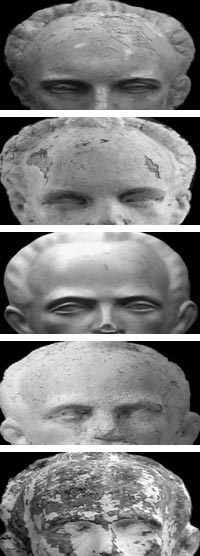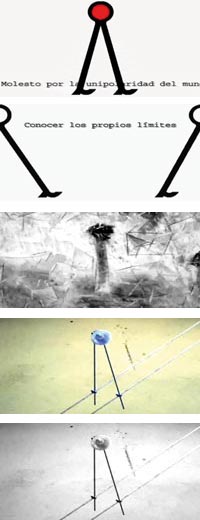It’s becoming increasingly common to perceive that human beings’ relations with reality –sometimes slippery within its own complex moves– is meddled by an intruder we have adopted as an extension of and as our more faithful eye: the photographic, video or movie camera.
Our obsessive need to store our own and somebody else’s images in portable memories in the form of chips or tapes leads us to bypass or at least take the beam off on what’s actually going on only to focus on its representation. It seems as if it just were a more “intense” relationship with a happening if we got it recorded. In a broader way, this is owed to the signs of a culture marked by television, cinema, the Internet and the conveniences that gave access to self-representation, first be means of analogical cameras and later on through digital and video cameras, even when today the boundaries melt into one another and the myth of the “snapshot” goes from a Polaroid to the shots we take with cell phones.
This is far more worrisome for those interested in the arts when it comes to deciding what to take and what to discard within the array of images that make the rounds every single day. It’s so powerful that artists have tried to impose a vision of their own without ignoring the possibilities of each and every artistic means in a bid to move beyond the strictly technological field and go deeper into the esthetic space. The history of videotape collects the critical proposals that several artists made back in the 1960s and 70s in the realm of television and its manipulation levels –one of the lines widely developed at the onset by Nam June Paik and Vosstell. In the same breath, it captures performances and public interventions and video installations as part of a collective willingness with necessary social implications. More recently and following the start of the digital revolution, it’s so commonplace to find a blend of different means: videos built in interactive installations that sometimes involve net art, graphics and animation. The result is a hybrid, undefined and hardly conventional art.
In Cuba, the use of video as a creative format and means has a short history. It basically came out and developed in the fields of audiovisual and the plastic arts, rather than as a critical review of television, its programming and expressive forms.[i] Even though back in the late 1980s some experimentation with it began by the hand of the National Video Movement and based on the referential experiments that documentary filmmaker Santiago Alvarez, Enrique Pineda Barnet and Nicolas Guillen Landrian had conducted for decades, it was in the 1990s when video creations finally came of age and reached a strength and personality of its own.

Indeed, in the course of the 90s and from the very first works made by moviemaker Enrique Alvarez (Polymite, 1991) to those made by recent graduates from the Higher Institute of Art and others linked to the plastic arts, like Raul Cordero and Luis Gomez, or video people hailing from the audiovisual and fiction fields, like Pavel Giroud, Magdiel Aspillada and Italo Exposito, a specific assessment of the possibilities of video as an expressive means is seen. There’s no doubt that the First Video Art Festival held in 2001 –alongside the Third Contemporary Art Exhibit– turned out to be a steppingstone for both the recognition and development of this artistic practice in the country. The Cuban public had access to a heterogenic assortment of proposals that pieced together –to a lesser or larger degree– documentaries of strong anthropological and social content with fiction works, animations and far-reaching visual experiments that showed tremendous stylistic and thematic abundance on the one hand, and on the other hand a terminological co-fusion that we still drag in tow. During that same period of time, the former Spanish Cultural Center in Havana brought up an array of projects that involved video arts, like Copy Right (2002) that revealed the most outstanding elements of this form of expression.[ii]2
In the beginning of the 21st century, the generalizing use of video as a format for installations, the documentation of performances and actions in public spaces showed the Cuban arts the way to the international circuit of biennials, fairs[iii] and different events that have shaped the new visual character of the nation arts overseas. It is no secret that these major events are increasingly showing audiovisual-oriented expositions and platforms rather than the more traditional artworks. This leads to both the legitimization of this means and the standardization of creative margins within the contemporary arts, occasionally determined by a number of influences in the extra-artistic field over the “must-be” sense of the arts.
The world can be made out from here…
If we were to make a quick tour through the history of the Cuban arts, we’ll see how the presence of women in the plastic arts was timely and decisive during the first half of the 20th century. The undisputed visibility of women in Cuba’s arts –as a subject of creation since it’s always been in it as an object– got an unprecedented leg up in the 1960s as they joined study programs at the National School of Art and, from 1976, at the Higher Institute of Art.[iv]
However, despite the possibilities and access of artistic co-ed, the field of visual arts in Cuba –more specifically the audiovisual world– continues to be a men’s-only land. And make no mistakes about it; an exhibit of made-by-women video art will help rebuff or tone down that belief. On the other hand, it will portray a women’s-only vision about a variety of topics, though not necessarily from a genre perspective.[v]
Singularizing the creation of a sector within Cuba’s young breed of fine artists who rely on video as their format of choice could be a discursive and exclusive limitation, but the fact of the matter is it does point to an increasingly overt trend triggered by the relative role these means play in the formation of these artists. Doing research on the possibilities of video is for each and every female artist I’ll mention below the way to transcend immediateness and walk into that space where the personal gives way to the public, where the perception of reality –regardless of it being local– makes a short shrift of global-scale references and concerns. Their works manage to articulate a proposal which is no stranger to the worldwide development of video art, laying bare some of research lines within today’s Cuban art with the necessary distance and serenity to avoid the concept they all come from, yet without just becoming a mere chronicle of it.
Tatiana Mesa walks down a path that kicks off with intimate feelings only to peruse a personal experience, leaving unnecessary dramatics behind. Farewell (2003) speaks about a gripping, unique, short-lived and individual feeling. The camera focuses on the faces, right between the swollen and shadowy eyes, as a tear rolls down silently without ever fading away. The documentation of this act presumes the invasion of that person’s intimacy that, at the same time, makes us accomplices, eyewitnesses of a moments, not matter what the causes or consequences really are. It’s just a fleeting moment.

Yaniezky Bernal also zeroes in on the subject, trying to rebuild its image from the fragment. But the subject comes out not through its physical status, but rather through its formal and visual ambiguity. In two of the works from The Standpoint series (2007), Bernal takes a segment of a face to run through the stereotype-making and recreation of such an icon as Jose Marti, Cuba’s national hero and founding father. The appearance the camera’s viewpoint gives to a nose’s alveoli –turning them into hollow eyes– is confronted in The Endless Work, the hero recreated in blind-eye busts that, as part of the nonstop metamorphosis it endures within the video, sees its identity getting depersonalized in a piecemeal fashion. The treatment of the realistic image –given the natural attachment to sculptures– grants this image quasi-tactile features. It’s a reflection on the abusive treatment of certain icons within as Cuban framework in which national attributes continue to be strong references.
There’s a different intention in Susana Delahante with her six-video series entitled El Narra (2007). The artist puts together pieces of a youngster’s life, a clearly marginal person from the Havana inner city. Though the image reveals a particular modus Vivendi (living on community charity, in the lookout, without a certain occupation or end in mind), the sound brings up the street talk. Indeed, the Narra or Chinaman name is attached to a subject whose discourse serves as a backdrop for the kind of marginal life of that individual we see in the image. A discourse that becomes some sort of narration or voice-over delirium, an insidious and provocative blend of politics, references to the national history, memories, discrimination, fragments of movies. Construed through a sequential order, El Narra sets out to showcase –from an anthropological point of view– a sector of the Cuban population and provides a comprehensive vision in which image and sound complement each other and get fully articulated.
On the other hand, the cityscape is material for further examinations and experiences to build on discourse related to the local and the universal. Watching the World (2007) by Maria Victoria Portelles, takes us on a grand tour around the streets of Havana, simulating a unique circular shape that every now and then stops at the “world sphere” that rests atop the Masonic Loggia building on the bustling Carlos III Avenue. This focus of attention that can be made out from different spots around the city and that the artist riveted her eyesight on in search of a “north” or beacon, speaks about the need to take on the burg, our burg, as a fragment and one of the possible representations of this world. An ever-changing and reconstruction-laden city. By immerging into the daily life, Watching the World shows us what we are and how far we can get as long as we manage to keep the distance and lock on the right perspective.
Analia Amaya also turns to the cityscape to reveal herself as part of the whole. Thus, Concerto (2006) is a poetic tribute to the city, to Havana seen from its streets and buildings, its twilight. The lights are attuned to musical notes that go on little by little and shed light on a beautiful urban landscape of checkered layout in which the color of some façades or the few neon lights contrast with the lack of life in its streets. An empty city that exists in its clear avenues and saddened buildings: the charm of a sonata in images. That’s exactly what we feel as we feast eyes on nature, a lightning bolt that draws a Fleeting Landscape in the sky or the raindrop that traces the Horizon through the window of a moving car. Analia resorts to an evocative view in search of the basics, the intimate, scanting on visual resources and relying on a cleanness that can only be construed under the influence that both Minimalism and Conceptualism have had on the contemporary arts. Yet, this time around the sensorial quality as the key to esthetic enjoyment is powered up.
However, there’s just another look that advocates for a formal and associative game of tremendous visual impact, exploring the creative possibilities of video art as an expression. That’s the goal that drives Diana Fonseca and Nadia Medina.
Diana Fonseca is a pretty interesting case in point. Her mastery of that means is owed to her thorough attention to details and her bonds with drawing design. Put together they create an imaginative game of shapes usually seen in fairy tales or children’s books. In one of her artworks –based on a mixture of rice and a black bean seed– the artists constructs a set of imaginary figures, shot frame by frame, that goes from one image to the next as if they were mutant creatures. Marked by heightened artistic values, the work relies on music to underscore its ludicrous shade, eventually a major element in the progression. In a similar way, in Garden I (circa 2006), the artist laid her hands on the natural motifs of traditional houses’ floor tiles to come up with some kind of animated cartoon but actually sticking to a particular “story.” It’s a pretext for formal experimentation, free association and liking for color, yet making use of the household space as a reference, the visual memory: the game of seeking figures and making up stories, the deployment of an entire universe of dreams and desires, the recovery of the wasted time.
The graphic component in Nadia Medina’s work could see eye to eye with Diana’s proposal. Nonetheless, Medina homes in on the field of communication and concepts, either through the overlapping of images (The World in Colors, 2001) or by blending graphic elements, animation and texts (The World in Black and White, 2004). The artist hinges on a study on the representation of mankind and its insertion in a context, the relations of adaptability and separation, all that much expressed from a synthetic, nearly ideal viewpoint that handles easy-to-understand visual codes. It’s all about the recognition of the individual in a variety of objects, in his willing to be able (or unable) to exert influence on the environment through the exercising of his criterion.
Rather than appraising the big issues, the proposals these seven artists have to offer show some of the ways today’s visual art has taken in Cuba, the necessary oxygenation that’s beginning to bear its first fruits and recognitions. It’s all about taking on the world as a context of well-defined physical, personal or geographical features: the microcosm from which an endless assortment of possible worlds can be built.
[i]Something that Jesus Hernandez developed a couple of years ago with his Clippings of the Informative Reality (Casa de las Americas, 2007).
[ii]Among the included artists: Analia Amaya, Angel Delgado, Raul Cordero, Luis Gomez, Carlos Garaicoa, and others. Later on in 2006, the Spanish embassy in Cuba and the Spanish International Cooperation Agency supported the Play exhibit (later on DVD) that collects the video visual work in the form of fiction films, TV commercials and video clips in an effort to showcase Cuba’s contemporary audio visual world.
[iii]Even an international video art festival and fair is held in Barcelona, LOOP, that questions the anti-commercial willingness that video art and many artistic practices from the 1970s on had proclaimed. The truth is that LOOP has turned out to be a yearly international meeting for the video art that gathers museums, collectors, galleries, artists, critics and researchers who attend its theoretical events. It’s quite interesting to see a current trend to blur the functions and goals of contemporary art fairs, biennials and festivals that make many people believe there are no differences whatsoever among all of them.
[iv]A number of boldface names with different creative interests and outreaches can be mentioned, like Antonia Eiriz, Zaida del Rio, Nelida Lopez, Marta Maria Perez Bravo, Consuelo Castañeda, Maria Magdalena Campos, Ana Albertina Delgado, and later on in the 1990s, the likes of Rocio Garcia, Belkis Ayon, Sandra Ramos, Aimee Garcia and Tania Bruguera, just to name but a few.
[v]Something worth mentioning is that Cuban female artists don’t seek to be excluded of their feminine condition, but rather speak in the same breath with their peers. I might even say they sometimes try to avoid having their works pigeonholed as “genre stuff” –if they were to leave that job for curators and scholars.
Publicaciones relacionadas

















